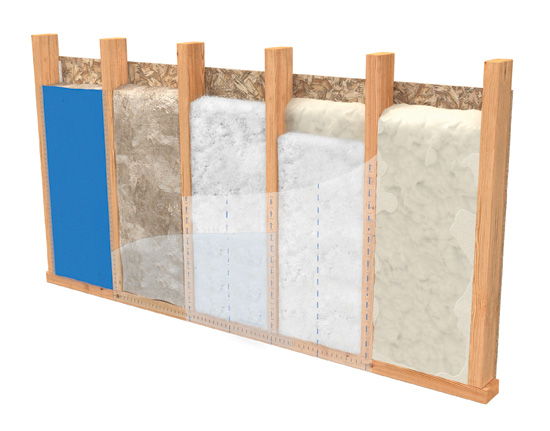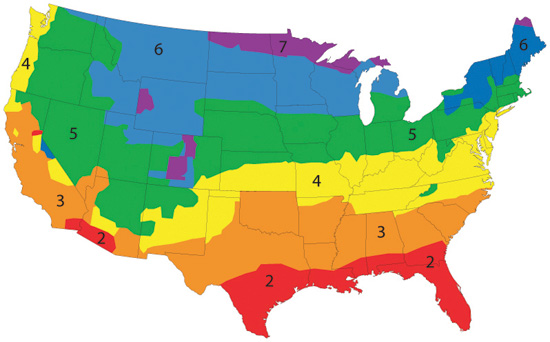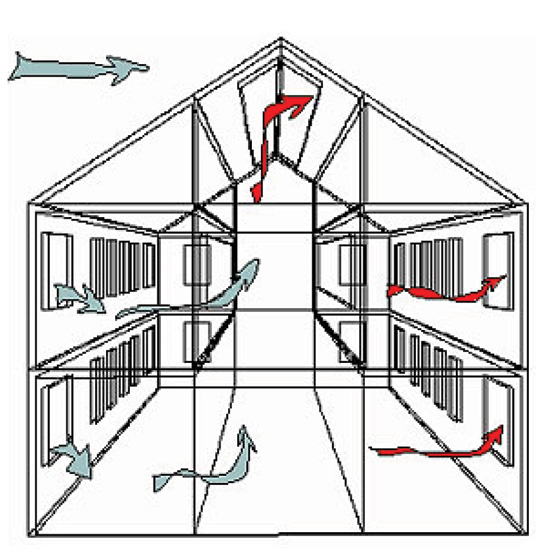The Science Behind Building Envelope Design in Framed Wall Assemblies
In creating this building envelope separation, we impose a lot requirements on a framed wall assembly. First, it needs to provide the appropriate degree of strength and rigidity, whether in response to imposed building loads, wind loads, or use requirements. This is usually achieved by a combination of framing member size, sheathing, and structural reinforcing as required. But we all know that other materials are required to create the full separation. To address interior needs, insulation is required to control heat flow, air barriers are needed to restrict unwanted air flow, and vapor barriers are required to prevent airborne moisture from entering into the wall assembly. On the exterior, the wall assembly needs to provide complete rain and weather protection. Throughout, building codes and standards will dictate material performance requirements including fire containment and control in some cases. And of course, the owner and design team will care about the economics of the system not to mention the final appearance and other considerations such as wall thickness and how that integrates with the rest of the building construction. Altogether, a framed wall assembly is a collection of a lot of different materials that need to come together to meet all of these different requirements and will directly impact the long-term comfort of the occupants, energy use of the building, and even the quality of the indoor environment.


Photos courtesy of CertainTeed Insulation
Different types of insulation are available to restrict thermal flow in framed walls including batts, blown in, and spray foam insulation products.
A properly designed and specified framed wall assembly delivers on the promise of overall integrity through a scientific analysis of materials and an understanding of the compatibility of different components of the assembly. Among the more significant factors is the clear continuity of each of the needed barriers (thermal, water, air, vapor) so that breaches do not occur and undermine the performance or integrity of the wall. But we are probably all too aware that defects and even failures in wall systems can and do occur. Why? There are known causes in both the design of walls and in their construction. For a designer, a lot of technical information has become available in recent years that can seem contradictory at times, making a clear design decision seem difficult to discern. Sometimes new or unproven systems or materials are specified without fully reviewing them only to discover too late that they do not live up to expectations. In other cases, failures may occur because different materials were incompatible or not properly integrated or interfaced into other construction systems. And there is also the thought that a single product can take care of a particular need without providing any back up or contingency in the design in case something does go awry.
There is another more basic, and common, mistake that can be made by design professionals too, namely to ignore climate differences found in different locations. A framed wall assembly that works just fine in one location may produce significantly different results in another. That is why energy codes and standards, along with government agencies, have identified and adopted climate zones as the basis for building envelope design across the United States. There are eight identified climate zones ranging from very warm and humid in the south to much colder and dryer in the north, and plenty of variations in between. Before any design, construction, or permitting processes start, the proper climate zone must be identified for a given building and the assembly developed to match that zone accordingly.

Image courtesy of CertainTeed Insulation
The eight climate zones of the United States have been adopted by energy codes and standards as the basis for determining building envelope needs.
Once bidding and construction begin, there is often the temptation to “value engineer” alternatives into the constructed building. Now in some cases value engineering can be a legitimate and useful tool. But improperly applied to frame wall assemblies, it may only save short-term construction costs at the expense of reduced long-term performance and potential cost exposure later on. During construction, quality control of the installed work is needed to achieve the intended results of any wall assembly and the only way to assess that is through routine inspection of the work as it progresses. This can help eliminate any questionable construction practices or work that is inconsistent with the contract documents, but it can also reveal any installation or procedural errors that can create defects that impact the performance of the wall.

Photo courtesy of CertainTeed Insulation
Numerous demands are placed on exterior framed wall construction to provide structure, protection from the elements, and integrity of materials over time.
Beyond routine field observation and inspections, building envelopes are increasingly subject to commissioning just as mechanical and electrical systems are. The logic behind this is simple since, in the broadest sense, commissioning helps ensure that building systems are designed, installed, tested, and capable of being operated and maintained according to the design intent and the owner's operational needs. Independent, objective, and qualified commissioning agents are typically used to perform this service which helps to assure that the review is impartial and appropriate. Informed by building science, and often motivated by avoiding potential problems, the use of commissioning agents for building envelopes, including framed exterior walls, is becoming more common.
Framed Wall Building Science
Simply put, the term building science describes the observation and application of scientific principles to buildings. The National Institute of Building Sciences (NIBS) offers a more complete insight in their publication the Whole Building Design Guide (WBDG, www.wbdg.org/resources/buildingscienceconcepts.php): “Building science is a field of knowledge that draws upon physics, chemistry, engineering, architecture, and the life sciences. Understanding the physical behavior of the building as a system and how this impacts energy efficiency, durability, comfort, and indoor air quality is essential to innovating high-performance buildings.” Since the nature of buildings is broad and diverse, it is not surprising that this definition is too. When it comes to framed exterior walls, however, there are four key elements of building science that are more focused which are summarized as follows:
Heat Flow
The fundamental rules of physics tell us that heat energy radiates in all directions from a source. If air or water is heated by that source, the warmed air or water will become less dense and rise which can cause convection currents to occur. If a heat source is in contact with a solid material then that material can conduct the heat directly through it. In all cases, once released, heat will always flow from a warm location to colder one, striving to achieve equilibrium between the two. The ability and time required to do that will depend on the degree of either connection or thermal separation between the two locations, for example inside and outside of a wall.
Air Pressure and Flow
In the natural environment, air pressure will vary based on things like weather, climate, altitude, etc. In man-made situations, such as airplane cabins and buildings, air pressure will also vary either by circumstance or by design. Once again the rules of physics tell us that equilibrium is the natural condition that is sought. In this case that means that higher pressure air will move or flow to an area of lower pressure air until the pressure is balanced between the two locations. That is why tires go flat on cars or bicycles and it is why air moves into or out of buildings. We can influence that movement passively by how tightly we seal rooms or walls or actively through the use of HVAC equipment that can create higher or lower pressure in selected areas.

Image courtesy of CertainTeed Insulation
Air flow in a building carries heat and moisture with it which can infiltrate exterior wall assemblies, causing unwanted consequences.









